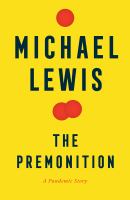Lately we’ve been hearing a lot about public health. But what is that? Simply put, it’s the health of a whole community rather than any single person. The public health field deals with everything from sanitation to food availability to– yes– infectious disease transmission. If you’re interested in learning more about this topic, there are a lot of new books that can help you out.
 Bestselling author Michael Lewis’s latest book, The Premonition, covers the pandemic experts who have predicted an outbreak on the scale of COVID-19, of which there are many. The characters you will meet in these pages are as fascinating as they are unexpected. A thirteen-year-old girl’s science project on transmission of an airborne pathogen develops into a very grown-up model of disease control. A local public-health officer uses her worm’s-eye view to see what the CDC misses, and reveals great truths about American society. A secret team of dissenting doctors, nicknamed the Wolverines, has everything necessary to fight the pandemic: brilliant backgrounds, world-class labs, prior experience with the pandemic scares of bird flu and swine flu…everything, that is, except official permission to implement their work. We also have this title on OverDrive as an ebook, and you won’t want to miss it. Lewis’s writing is always as dynamic and interesting as it is technical and informative. It’s been called a “nonfiction thriller” and it’s easy to see why. As we all struggle to process what our lives have been for the last year and a half plus, this book might help some of us make sense of it.
Bestselling author Michael Lewis’s latest book, The Premonition, covers the pandemic experts who have predicted an outbreak on the scale of COVID-19, of which there are many. The characters you will meet in these pages are as fascinating as they are unexpected. A thirteen-year-old girl’s science project on transmission of an airborne pathogen develops into a very grown-up model of disease control. A local public-health officer uses her worm’s-eye view to see what the CDC misses, and reveals great truths about American society. A secret team of dissenting doctors, nicknamed the Wolverines, has everything necessary to fight the pandemic: brilliant backgrounds, world-class labs, prior experience with the pandemic scares of bird flu and swine flu…everything, that is, except official permission to implement their work. We also have this title on OverDrive as an ebook, and you won’t want to miss it. Lewis’s writing is always as dynamic and interesting as it is technical and informative. It’s been called a “nonfiction thriller” and it’s easy to see why. As we all struggle to process what our lives have been for the last year and a half plus, this book might help some of us make sense of it.
 A topic that’s become much more relevant to us all in recent years is quarantine. Until Proven Safe: The History and Future of Quarantine by Geoff Manaugh and Nicola Twilley examines the roots and evolution of this practice. Considering research was begun long before a pandemic turned this concept into a daily reality for many, Manaugh and Twilley spent time chasing the story of emergency isolation through time and space–from the crumbling lazarettos of the Mediterranean, built to contain the Black Death, to an experimental Ebola unit in London, and from the hallways of the CDC to closed-door simulations where pharmaceutical execs and epidemiologists prepare for the outbreak of a novel coronavirus. They also looked into environmental applications, such as nuclear waste sites, taking the idea of quarantine far beyond its infectious disease roots and into a realm that’s also unfortunately familiar to citizens of our modern world.
A topic that’s become much more relevant to us all in recent years is quarantine. Until Proven Safe: The History and Future of Quarantine by Geoff Manaugh and Nicola Twilley examines the roots and evolution of this practice. Considering research was begun long before a pandemic turned this concept into a daily reality for many, Manaugh and Twilley spent time chasing the story of emergency isolation through time and space–from the crumbling lazarettos of the Mediterranean, built to contain the Black Death, to an experimental Ebola unit in London, and from the hallways of the CDC to closed-door simulations where pharmaceutical execs and epidemiologists prepare for the outbreak of a novel coronavirus. They also looked into environmental applications, such as nuclear waste sites, taking the idea of quarantine far beyond its infectious disease roots and into a realm that’s also unfortunately familiar to citizens of our modern world.
 One of the most valuable developments in public health is vaccination. In The Vaccine Race, Meredith Wadman takes a look at the development of not our current cutting-edge vaccine, but one for rubella. Until the late 1960s, tens of thousands of American children suffered crippling birth defects if their mothers had been exposed to rubella, popularly known as German measles, while pregnant; there was no vaccine and little understanding of how the disease devastated fetuses. In June 1962, a young biologist in Philadelphia produced safe, clean cells that allowed the creation of vaccines against rubella and other common childhood diseases. Two years later, in the midst of a devastating German measles epidemic, his colleague developed the vaccine that would one day wipe out homegrown rubella. The rubella vaccine and others made with those cells have protected more than 150 million people in the United States, the vast majority of them preschoolers. This book follows scientists, politicians, and the public response to the vaccine’s development and rollout, some of which may look familiar in our current environment.
One of the most valuable developments in public health is vaccination. In The Vaccine Race, Meredith Wadman takes a look at the development of not our current cutting-edge vaccine, but one for rubella. Until the late 1960s, tens of thousands of American children suffered crippling birth defects if their mothers had been exposed to rubella, popularly known as German measles, while pregnant; there was no vaccine and little understanding of how the disease devastated fetuses. In June 1962, a young biologist in Philadelphia produced safe, clean cells that allowed the creation of vaccines against rubella and other common childhood diseases. Two years later, in the midst of a devastating German measles epidemic, his colleague developed the vaccine that would one day wipe out homegrown rubella. The rubella vaccine and others made with those cells have protected more than 150 million people in the United States, the vast majority of them preschoolers. This book follows scientists, politicians, and the public response to the vaccine’s development and rollout, some of which may look familiar in our current environment.
